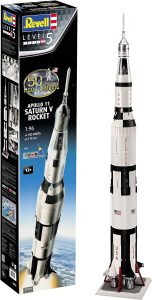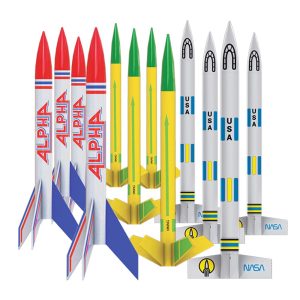Imagine soaring to new heights, defying gravity, and exploring the thrill of space travel without leaving the ground. Welcome to the world of model rockets, where creativity meets science, and the sky's the limit! Whether you're a curious kid, a seasoned enthusiast, or just looking for a fun project to share with friends and family, model rockets offer an unforgettable adventure that's out of this world.
Quick Links to Useful Sections
What Are Model Rockets?
Model rockets are scaled-down versions of real rockets, designed to replicate the excitement of space exploration without the enormous costs and complexities. They're typically made of lightweight materials, such as plastic, wood, or paper, and powered by small motors that produce a controlled thrust.
From simple, beginner-friendly kits to advanced, custom-built models, there's a model rocket for every skill level and interest. Whether you're looking to learn about science, technology, engineering, and mathematics (STEM) concepts, develop your problem-solving skills, or simply have a blast, model rockets offer an engaging and rewarding experience.
The Science Behind Model Rockets
Model rockets work by harnessing the energy released from a burning fuel, typically a combination of ammonium perchlorate and a plasticizer, which produces a high-pressure gas. This gas is then expelled through a narrow nozzle, generating a reaction force that propels the rocket upward.
As the rocket gains altitude, air resistance slows it down, and the force of gravity pulls it back toward the ground. By carefully designing the rocket's shape, size, and weight, model rocketeers can optimize its performance, achieving impressive heights and stable flights.
Looking For The Best Model Rocket Kits? You'll Love These:
Types of Model Rockets
The world of model rockets is incredibly diverse, with a wide range of styles, sizes, and complexities to choose from. Here are some popular types of model rockets:
- Beginner Rockets: Simple, easy-to-assemble kits perfect for kids and newcomers to the hobby.
- Mid-Power Rockets: More advanced models that require some skill and experience, offering higher performance and longer flights.
- High-Power Rockets: Large, complex models that demand expertise and specialized knowledge, capable of reaching incredible heights and speeds.
- Scale Models: Accurate replicas of real rockets, often featuring intricate details and realistic designs.
- Competition Rockets: High-performance models designed for competitive flying, emphasizing speed, altitude, and precision.
Getting Started with Model Rockets
Ready to blast off into the world of model rockets? Here's a step-by-step guide to help you get started:
- Choose a Kit: Select a beginner-friendly kit that suits your skill level and interests.
- Assemble the Rocket: Follow the instructions to build your model, taking care to ensure accurate construction and attention to detail.
- Prepare for launch: Find a safe, open area with minimal wind and obstacles, and set up your launchpad and equipment.
- Launch and Recover: Launch your rocket, track its flight, and recover it safely after landing.
Tips and Tricks for model rocket Success
To ensure a successful and enjoyable model rocket experience, keep these tips in mind:
- Always Follow Safety Guidelines: Wear protective gear, ensure a safe launch site, and never launch near people or animals.
- Choose the Right Motor: Select a motor that matches your rocket's design and weight, and always follow the manufacturer's instructions.
- Pay Attention to Weather: Avoid launching in strong winds, heavy rain, or extreme temperatures.
- Practice Makes Perfect: Don't be discouraged by initial failures – use them as opportunities to learn and improve.
Model Rocket Communities and Resources
Joining a model rocket community or seeking out resources can help you connect with like-minded enthusiasts, learn new skills, and stay up-to-date with the latest trends and developments.
- Local Model Rocket Clubs: Look for clubs in your area, where you can meet fellow enthusiasts, share knowledge, and participate in launches.
- Online Forums and Groups: Join online communities, social media groups, and forums dedicated to model rockets, where you can ask questions, share experiences, and learn from others.
- Tutorials and Guides: Find online tutorials, videos, and guides that offer step-by-step instructions, tips, and advice on model rocket building, launching, and maintenance.
Frequently Asked Questions About Model Rockets
Here are some common questions and answers about model rockets:
1. How high can model rockets fly?
Depending on the design and motor, model rockets can reach altitudes ranging from a few hundred feet to several thousand feet.
2. Are model rockets safe?
When used properly and following safety guidelines, model rockets are safe and enjoyable. However, they can be hazardous if mishandled or launched near people or animals.
3. Can I build my own model rocket?
Yes! With some creativity, patience, and skill, you can design and build your own custom model rocket.
4. How much do model rockets cost?
Model rocket kits and accessories vary in price, ranging from under $10 to over $100, depending on the complexity and quality of the components.
5. Can I launch model rockets in my backyard?
It's generally recommended to launch model rockets in a safe, open area with minimal obstacles and wind, such as a park or a designated model rocket launch site.
Resources and Community Support: Your Next Steps
Now that you've embarked on the exciting journey of model rockets, here are some resources to help you continue learning, growing, and thriving:
- Model Rocket Clubs and Organizations: Look for local clubs, national organizations, and online communities that offer support, guidance, and camaraderie.
- Online Forums and Groups: Join online forums, social media groups, and specialized platforms dedicated to model rockets, where you can ask questions, share experiences, and learn from others.
- Tutorials and Guides: Find online tutorials, videos, and guides that offer step-by-step instructions, tips, and advice on model rocket building, launching, and maintenance.
Remember, the world of model rockets is all about exploration, creativity, and community. Stay curious, keep learning, and always strive for excellence – and most importantly, have fun!
Looking For The Best Model Rocket Kits? You'll Love These:
Useful Interruption: Dive deeper into the world of Model Rockets with our most popular sections. If there is anything you think is missing or anything you would love for us to write about, just give us a shout.
- Getting Started & Basics With Model Rockets
- Model Rocket Design, Build & Customization
- Model Rocket Propulsion & Engine Technology
- Model Rocket Launch Techniques & Recovery
- Model Rocket Advanced Rocketry & Innovations
- Model Rocket DIY and Customization
- Model Rocket Equipment Reviews & Digital Tools
- Community, Competitions & Education
- Model Rocket Troubleshooting & FAQs
- Model Rocket Bonus/Seasonal & Niche Topics
A group of model rocket enthusiasts gathered at a field for their weekly launch event. Among them was Dave, a seasoned builder known for pushing the limits of hobby rocketry. This time, he had outdone himself.
“Ladies and gentlemen,” Dave announced, dramatically pulling a cloth off his latest creation, “I present to you: The Kraken!”
The crowd gasped. This wasn’t just a model rocket, it was a monster. The thing stood 8 feet tall, had six clustered engines, and was covered in enough duct tape to qualify as a classified aerospace project.
“Dave,” muttered Steve, the cautious safety officer, “Have you, uh… done the math on this?”
“Math?” Dave scoffed. “I built it in my garage at 3 a.m. with parts from eBay. This is an art piece, Steve.”
The countdown began.
5…
4…
3…
2…
1…
The engines ignited with a BOOM, and The Kraken shot up… kind of. It immediately did a violent barrel roll, narrowly missing the spectators before skyrocketing at an angle that could only be described as “legally questionable.”
The crowd collectively ducked as The Kraken flew straight over the adjacent cornfield, where Old Man Jenkins, the grumpiest farmer in town, was minding his business.
KABOOM!
The rocket disappeared behind the barn. A moment later, a flaming piece of Estes igniter wire landed at Steve’s feet. The silence was deafening.
And then, an unmistakable sound echoed across the field.
Jenkins’ shotgun being cocked.
“DAVE!!!” Steve shouted. “RUN.”
And that was the day Dave invented the first-ever biologically powered rocket booster: pure adrenaline.
To this day, nobody knows where The Kraken landed, but legend has it, it still haunts the skies, terrifying unsuspecting drones and low-flying birds.















